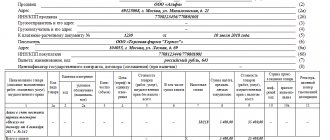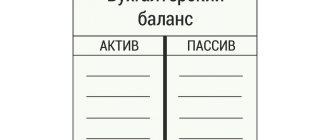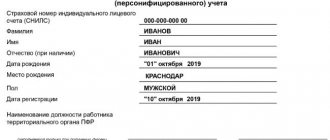Why do you need an off-balance sheet account of a budget organization?
Such accounts are auxiliary accounting accounts.
The balances for them are not included in the balance sheet and are illustrated behind the results of the main balance sheet, that is, behind the balance sheet. They do not affect the financial result and are not reflected in the periodic and final reports of the organization. The use of off-balance sheets in the accounting of a budgetary institution is regulated by Instruction 157n (section 7). This section provides a list of assets that should not be included in balance sheet accounts. According to current legislation, institutions have the right to adjust this list and, if necessary, include other inventory items in it.
Typical postings for 21 accounts “Semi-finished products of own production”
The main entries for 21 accounts used in accounting are shown in the table below:
| Account debit | Account credit | Operation description |
| 21 | 20 | Receipt of semi-finished products of own production |
| 21 | 23 | Receipt of semi-finished products manufactured by auxiliary production |
| 21 | 40 | Receipt of finished products for subsequent use as semi-finished products |
| 21 | 91.01 | Surplus semi-finished products identified during inventory were capitalized |
| 20 | 21 | Semi-finished products are sent to production for subsequent processing |
| 23 (25;26) | 21 | The cost of semi-finished products is included in the costs of auxiliary production (overall production costs; general business expenses) |
| 28 | 21 | Write-off of defective semi-finished products of own production |
| 91.02 | 21 | The cost of semi-finished products of own production, written off or sold, is reflected in other expenses |
| 94 | 21 | The identified shortage of semi-finished products is reflected |
Off-balance sheet budget accounts in 2021
The list of standard off-balance sheet accounts was approved by Order of the Ministry of Finance of Russia No. 157n. It is planned to keep records using the 31st off-balance sheet account: numbers from 1 to 27, as well as 30, 31, 40 and 42.
• Account 01 “Property received for use.” Registration of property is carried out on the basis of an acceptance certificate or other document that confirms receipt of the property and rights to it. Property must be reflected at the cost indicated in the transfer and acceptance certificate. Records are kept by lessors (owners) for each property. In the quantitative and total accounting card, the object must be reflected under the inventory number assigned to the object by the owner. • Account 02 “Material assets accepted for storage.” Material assets are accounted for on the basis of a primary document that confirms their receipt: a transfer and acceptance certificate, an agreement, etc. Objects are reflected at the cost indicated in the primary document. If the institution executed the deed unilaterally - according to the conditional valuation: one object - 1 ruble. In the quantitative and total accounting card, the object must be reflected in the context of owners (customers), by type, grade and storage location. • Account 05 “Material assets paid for through centralized supply.” Accounting is maintained by institutions that order supplies. Material assets are reflected on the basis of documents that confirm the shipment to the consignee in the amount of payments for their acquisition. Accounting is maintained in the Book of Records of Material Assets for each consignee and type of assets. • Account 06 “Debt of students for unreturned material assets.” Debt is taken into account in the amount of expenses for restoration or acquisition of similar property. Accounting is maintained in the Funds and Settlements Accounting Card by type of income, each student and type of value. • Account 07 “Awards, prizes, cups and valuable gifts, souvenirs.” The property is accepted into the account: - according to conditional valuation - received awards, prizes, cups, banners; - at the cost of acquisition - valuable gifts, souvenirs and material assets purchased for presentation (awarding). Accounting is carried out in the Card of quantitative and total accounting for financially responsible persons, storage locations and each item. • Account 09 “Spare parts for vehicles”. Spare parts are accepted for off-balance sheet accounting at the time they are written off from the balance sheet for vehicle repairs, and are taken into account during the period of operation as part of the vehicle. Accounting is carried out in the Card of quantitative and total accounting by persons who received spare parts, by vehicles and by types of spare parts and their quantity. • Account 12 “Special equipment for carrying out research work under contracts by customers.” Equipment is accounted for at the cost indicated by the customer in the primary transfer documents. Accounting is carried out in the Card of quantitative and total accounting in the context of work topics, responsible persons, storage locations, by type of equipment and quantity. • Account 13 “Experimental devices”. Objects are registered at their cost, which is attributed to the increase in R&D costs. Accounting is carried out in the Card of quantitative and total accounting in the context of responsible persons, storage locations by type of valuables, their quantity and value. • Account 21 “OS worth up to 3,000 rubles inclusive in operation.” Registration is carried out on the basis of a primary document when transferring an asset worth up to 3,000 rubles. into operation, with the exception of real estate and library assets. Accounting is carried out at the cost established in the accounting policy: according to conditional valuation - 1 rub. for one object or at book value. Accounting is carried out in the Card of quantitative and total accounting in the context of fixed assets and centers of financial responsibility. Objects are written off from the account only by decision of the commission on the basis of an acceptance certificate or a write-off act. • Account 22 “Material assets received through centralized supply.” Property that was received through centralized supply is registered until the Notification (f. 0504805) and copies of the supplier’s documents are received. • Accounts 24 “Property transferred for trust management”, 25 “Property transferred for paid use (rent)” and 26 “Property transferred for free use”. Registration of property is carried out on the basis of an acceptance certificate, at the cost specified in the act. Accounting is carried out in the Card of quantitative and total accounting in the context of managers or users, their locations, by type of property in the structure of groups: real estate; especially valuable movable property; other movable property; property - leased items; non-financial assets that make up the treasury. • Account 27 “Material assets issued for personal use to employees (employees).” Objects are accepted for off-balance sheet accounting at book value based on the primary document. Accounting is carried out in the Card of quantitative and total accounting in the context of users of property, location, by type of property, its quantity and value.
We recommend reading: Schedule of Issuance of Scholarships from MSTU Im Bauman
The procedure for writing off inventory items from an off-balance sheet account
- Acceptance for storage - this is what the account is intended for. 002 “Inventory and materials accepted for safekeeping” of the Chart of Accounts (approved by order of the Ministry of Finance of the Russian Federation dated October 31, 2021 No. 94n).
- Acceptance of materials from other companies for processing - records of these operations are kept on the account. 003 “Materials accepted for processing.”
- Commission agents account for goods for resale on the account. 004 “Goods accepted for commission.”
- form MX-3 or a similar document developed by the organization (taking into account the requirements of paragraph 2 of Article 9 of Law No. 402-FZ) to record the return of valuables accepted under a storage agreement;
- TORG-12, UPD or other documents - upon disposal of inventory items that were taken into account on the account. 002 within the framework of the supply agreement.
How to properly use off-balance sheet accounts
Material assets, raw materials and inventories received from third-party organizations, individuals or individual entrepreneurs should be reflected on the account. 002. Also, these off-balance sheet accounts are needed to reflect information about inventory items, for which ownership transfers only after full payment. Such conditions are fixed in the agreement or supply contracts.
What is an off-balance sheet account in accounting? Sub-accounts are special auxiliary accounting accounts that are designed to reflect information about property, assets and liabilities that do not belong to the company by right of ownership, but are transferred for temporary use. In other words, off-balance sheet accounts are used to collect and summarize information that is not included in the balance sheet.
Fixed assets of a budgetary institution
Fixed assets include material objects used in the course of the institution's activities when performing work or providing services, or the management needs of the institution, regardless of the cost of fixed assets with a useful life of more than 12 months.
Amounts received by institutions from the sale or dismantling of fixed assets (except for buildings and structures) remain at the disposal of the institution with the right to further use them for repairs, modernization or acquisition of new assets for the same purpose. At the same time, funds received from the sale and dismantling of fixed assets acquired using extra-budgetary funds are used only after paying taxes established by law. The amounts received by institutions from the sale or dismantling of buildings and structures are included in the income of the budget from which these institutions are maintained (Table.
We recommend reading: Do Bailiffs Remove Compensation for Sanatoriums?
Solution
The practical use of management accounting (previously it was known as operational-technical accounting) eliminates the difficulties that arise. With its help, semi-finished products can be taken into account in physical terms. Meanwhile, experts note that the unfinished method is preferable. It does not involve maintaining an account 21. The transfer of products to the warehouse is reflected exclusively in management documentation. In this case, it is advisable inside the account. 20 show the movement of semi-finished products in physical equivalent.
Write-off of fixed assets from an off-balance sheet account 21
- will inspect the fixed asset (unless, of course, it is stolen and is available);
- evaluate the possibilities of further use and the feasibility of restoring the object;
- will establish the reasons for liquidation (physical and moral wear and tear, accident, natural disasters, etc.);
- will identify the perpetrators if the object is liquidated before the end of its standard service life due to someone else’s fault;
- will determine whether it is possible to use individual components, parts or materials of the liquidated fixed asset.
In accounting, reflect the disposal of fixed assets from off-balance sheet account 21 on the basis of the decision of the permanent commission on the receipt and disposal of assets, formalized by the write-off act.. Reflect the write-off of an object from off-balance sheet using a simple system, that is, simply a decrease in off-balance sheet account 21. The double entry method is here. does not apply. This is stated in paragraph 2 of paragraph 332 of the Instructions to the Unified Chart of Accounts No. 157n.
Selling on the side
A new addition to the Instructions for using the Plan is that the sale of semi-finished products can be carried out not only to enterprises, but also to individuals. If these operations are carried out systematically, then account 21 does not apply. When reflecting processes, an account is used. 43, summarizing information about finished products. However, if this fact is episodic in nature, then writing off 21 accounts is carried out as follows:
- db sch. 90.2 CD count. 21 or
- db sch. 91.2 Kd 21.
The choice of account 90 or 91 will depend on whether the sale of semi-finished products is part of the company’s normal activities or not. Meanwhile, the key entries will be:
1. db count 21 CD count. 20 – semi-finished products are transferred to the warehouse.
2. db sch. 20 CD count. 21 – the unit received previously produced products for further processing.
What to consider on off-balance sheet account 02 in 2021
As you can see, the latest changes do not exclude any types of property recorded in off-balance sheet account 02. On the contrary, this list has been supplemented with material assets that do not meet the criteria of assets.
In connection with the introduction of the Standards “Fixed Assets” and “Conceptual Framework”, the provisions of Order No. 52n of the Ministry of Finance of Russia dated March 30, 2021 (hereinafter referred to as Order No. 52n) were changed regarding the completion of the Inventory List (matching sheet) for non-financial assets (f. 0504087 ). In addition, the said order also determines the procedure for filling out this document (Appendix No. 5 to Order No. 52n).
Financial statements
Regardless of which method - semi-finished or unfinished - a company uses, it needs to pay taxes. The buyer company can recover the tax. To do this, you need to specify the operation code correctly. It is important not to make a mistake here. If the restoration is carried out according to an adjustment invoice, code 18 is entered. If this operation is carried out in relation to the deduction claimed for deduction from the listed advances, then the numbers will be different. In particular, the code is 21. Often, enterprises confuse these numbers. Companies often indicate one invoice code - 21.
Accounting entries for fixed assets in budgetary organizations
Budgetary organizations are institutions financed from budgetary funds. Accounting in such organizations is carried out on the basis of a special chart of accounts for budgetary institutions with their own entries, which is approved by Order No. 174n of the Ministry of Finance of the Russian Federation dated December 16, 2021. In all budgetary institutions, fixed assets, according to Instruction No. 25n, are accounted for in account No. 010100000 - Basic facilities.
Fixed assets are recorded in accounting registers at their original cost. It includes the costs of purchasing and constructing facilities, consulting services, delivery and other costs required to bring the facility into a state of readiness for operation, taking into account the VAT charged. Accounting in budget accounting accounts is carried out in rubles and kopecks.
Specifics of posting
The key problem when reflecting semi-finished products of own production is their valuation. In this case, three approaches are used:
- Cost of objects. Theoretically, this method is considered the most correct option. But it is accompanied by a rather labor-intensive calculation process. Moreover, the accuracy of the calculations will be highly questionable.
- Conditional price. It is determined in accordance with a special price tag that is introduced at the enterprise.
- Transfer price. It is used in all cases of internal cost accounting. He assumes that one workshop sells semi-finished products, and the other, accordingly, purchases them. This method is effective in situations where the selling unit has the right to independently set the price. In this case, the second workshop can purchase them internally or externally at its discretion.
Federal standard “Fixed assets” - accounting from 2021 in 1C: BSU
On January 1, 2021, the federal accounting standard for public sector organizations “Fixed assets”, approved by order of the Ministry of Finance of the Russian Federation dated December 31, 2021 No. 257n, came into force. The standard introduces uniform requirements for accounting for fixed assets, their classification and depreciation. Let's look at the most significant changes using practical examples in 1C: BGU 8 edition 2.0.
Written off upon commissioning to off-balance sheet account 21. Previously, this limit was 3,000 rubles. Let's look at an example: we bought a cabinet worth 9,500 rubles. The first document that we create in 1C: BSU is “Receipt of OS, intangible assets, legal acts.”
We recommend reading: How much does a monthly train subscription cost during weekdays?
Depreciation of fixed assets
Government institutions charge depreciation of fixed assets linearly over their service life. There is also a rule of monthly accruals in the amount of 1/12 of the annual amount. Depreciation charges begin to be reflected in the month following the month the facility is put into operation.
Read about the practical application of the linear method in the article “Linear method of calculating depreciation of fixed assets (example, formula)” .
The useful life is determined based on:
- the expected period of receipt of economic benefits;
- recommendations contained in the manufacturer's documents;
- warranty period for use of the object;
- other methods described in clause 35 of the Standard
Depreciation is reflected in the synthetic account 010400000 “Depreciation”.
To record entries for depreciation charges, analytical accounts ending in 410 are used, which are used in the following transaction: Dt 040120271 “Depreciation costs of fixed assets and intangible assets”, 010900000 “Costs of manufacturing finished products, performing work, services” (010960271, 010970271 , 010980271, 010990271) Kt 010400000 “Depreciation” (010411410–010413410, 010415410, 010418410, 010431410–010438410).
To account for fixed assets leased: Dt 040120271 “Depreciation costs of fixed assets and intangible assets” Kt 010440000 “Depreciation of leased items” (010441410–010448410).
In paragraphs 19, 20 instructions to the chart of accounts (order No. 162n) consider special cases of reflecting depreciation, for example, for fixed assets received free of charge.
Rebus Company
Over time, fixed assets physically wear out and become obsolete. If it is impossible to restore an object or its further use is not economically feasible, then it is liquidated and written off from the register.
The regulations on the commission and its composition are approved by the head of the institution. Include employees with specialized knowledge in the commission. Thus, the commission may include the chief accountant, financially responsible persons, and other employees who have technical knowledge of the item being written off. If there are no such employees in the institution, or additionally, the chairman of the commission may invite experts.
Accounting for off-balance sheet accounts in 1C
For accounting in the program “1C: Public Institution Accounting 8”, ed. 2.0. non-exclusive rights to use software products are provided for in the document “Acceptance for accounting of fixed assets (except buildings and structures) (OS-1) (Order 173-)” with the type of operation “Receipt to account 101 (102, 103), 01, 02”.
1. Account 01 accounted for each individual object of non-financial assets with inventory numbers assigned by the balance sheet holder and indicated in the transfer and acceptance certificate. In this case, the accounting object was assessed at its value indicated by the balance sheet holder. In the absence of a valuation of objects, it is allowed to take into account the conditional valuation - 1 object = 1 ruble.
Off-balance sheet accounts of budgetary institutions
- Account 10 “Ensuring the fulfillment of obligations.” Collaterals are accepted for accounting according to source documents in the amount of the obligation for which the collateral was received. Accounting is kept in a multigraph card in the context of obligations by type of property (collateral), its quantity, storage locations and obligations for which the property was received as security. The collateral is written off if obligations are fulfilled.
- Account 11 “State municipal guarantees”. Accounting is kept in the card for accounting funds and settlements in the context of subjects of civil rights and obligations for which guarantees are provided, by type and amount of guarantee. Collateral amounts are debited from the account when the obligations in respect of which the guarantee was provided are fulfilled.
To account for receivables and payables on the off-balance sheet, two accounts are provided: account 04 “Debt of insolvent debtors” and account 20 “Debt unclaimed by creditors”.
How is an inventory of off-balance sheet accounts carried out?
After the inventory has been completed, final acts are drawn up. Commission members and financially responsible employees put their signatures on them. Inventory results must be reflected in accounting. Deficiencies are recorded as follows:
Off-balance sheet accounts are needed to record property and liabilities that are not recorded on balance sheet accounts. Order of the Ministry of Finance No. 94n dated October 31, 2021 stipulates 11 such accounts. Inventory is necessary to establish whether the real state of the property corresponds to the information recorded on off-balance sheet accounts.
Sample act for writing off goods and materials from an off-balance sheet account
Total… signatures) (position)(signature)(signature decoding) (position)(signature)(signature decoding) Download the document » Download a sample document “Act on writing off non-financial assets from the off-balance sheet accounting of an educational institution” Appendices to the document: What other documents are there: What more download on the topic “Act”:
- release of materials into production;
- sale of materials by the organization to individuals and legal entities;
- write-off of materials that have become unusable after expiration of storage periods;
- write-off of obsolete equipment;
- write-off when shortages, theft or damage are identified, including due to accidents, fires, and natural disasters.
Approval procedure
Currently, there is a Regulation on the specifics of writing off federal property, approved by Decree of the Government of the Russian Federation of October 14, 2010 No. 834 (hereinafter referred to as the Regulation on Write-off). This resolution defines the specifics of writing off movable and immovable property in federal ownership and applies to all federal government institutions, regardless of their type. According to clause 2 of the Regulations on Write-off, write-off of federal property is understood as a set of actions related to the recognition of property as unsuitable for further use for its intended purpose and (or) disposal due to the complete or partial loss of consumer properties, including physical or moral wear and tear, or having been retired from use. possession, use and disposal due to death or destruction, as well as the impossibility of establishing its location. The meaning of writing off property in this paragraph partly coincides with the conditions for recognizing property as an asset given in paragraph 8 of the GHS OS, with the exception that this paragraph talks about the need to take into account property that is not recognized as an asset off the balance sheet. And according to the Regulations on write-off, property disposed of during write-off, as a rule, is on the balance sheet until the final decision of its owner. The regulation on write-off requires the creation on an ongoing basis of a commission to prepare and make the appropriate decision. Note! In accordance with clause 7 of the Regulations on write-off, the period for consideration by the write-off commission of documents submitted to it should not exceed 14 days. The procedure for agreeing on a decision to write off property at the federal level is regulated by the joint Order of the Ministry of Economic Development of the Russian Federation and the Ministry of Finance of the Russian Federation dated March 10, 2011 No. 96/30n
.
According to clause 3 of this procedure, federal executive authorities are given 45 calendar days
from the moment they receive the relevant documents for their consideration or for sending a refusal to approve the write-off decision. As can be seen from the above, the period of approval procedures until the moment of write-off can last about two months, and in practice this period can be even longer.
How to write off from an off-balance account
- form MX-3 or a similar document developed by the organization (taking into account the requirements of paragraph 2 of Article 9 of Law No. 402-FZ) to record the return of valuables accepted under a storage agreement;
- TORG-12, UPD or other documents - upon disposal of inventory items that were taken into account on the account. 002 within the framework of the supply agreement.
When writing off fixed assets from off-balance sheet account 21 “Fixed assets worth up to 3,000 rubles. inclusive in operation”, you must follow the same rules for disposing of property as for all other property of the institution.
Results
Budgetary accounting of fixed assets has a complex structure of accounts and their coding.
However, the instructions listed in the article contain detailed explanations and lists of possible entries that can help the accountant. Maintaining budgetary accounting of fixed assets is strictly regulated. All movements of fixed assets must be documented in primary documents and reflected in accounting by accounting entries. You can find more complete information on the topic in ConsultantPlus. Free trial access to the system for 2 days.






